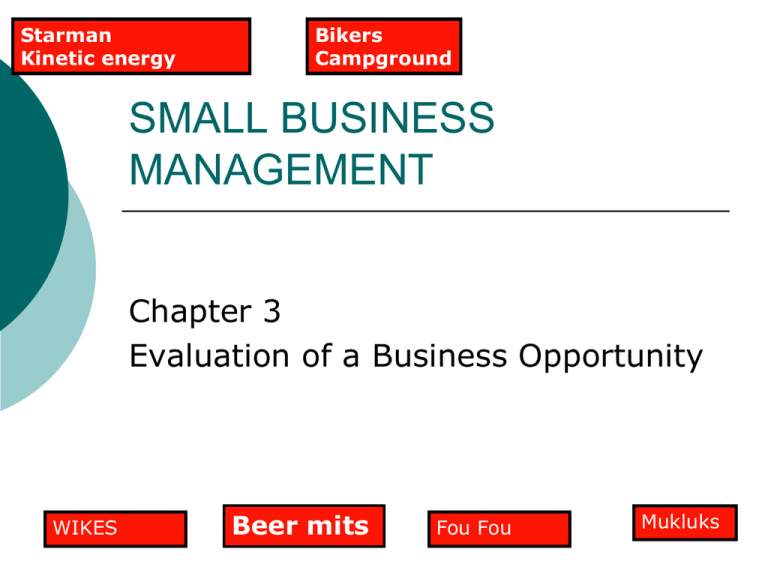
Starman
Kinetic energy
Bikers
Campground
SMALL BUSINESS
MANAGEMENT
Chapter 3
Evaluation of a Business Opportunity
WIKES
Beer mits
Fou Fou
Mukluks
CHAPTER OBJECTIVES
1. To review the nonquantitative aspects of evaluating
business opportunities.
2. To introduce the methods by which an entrepreneur can
enter a market with a product or service.
3. To discuss the types of information available to assist in
the quantitative analysis to select a small business and
illustrate how that information can be used.
4. To discuss ways that the entrepreneur can develop a
strategic competitive advantage.
5. To provide a systematic way to quantitatively assess an
industry and evaluate the financial feasibility of a specific
small business opportunity.
Entrepreneurial Process
The process of starting a new venture
can be referred to as the Entrepreneurial
Process
Identification and evaluation of opportunity
Development of a business plan
Determination of the resources required
Management of the business
Copyright © 2014 McGraw-Hill Ryerson.
All rights reserved.
Entrepreneurial Process
Ideas
All businesses start with one thing—an idea.
Without ideas there would be no businesses
or entrepreneurship
Copyright © 2014 McGraw-Hill Ryerson.
All rights reserved.
Entrepreneurial Process
Sources of New Ideas
Occupations
Hobbies
Drawing from Experience
Observations – NY Fries
Existing Products and Services
Deliberate Searches
Focus groups, brainstorming
Sources of ideas for new business
45%
40%
35%
30%
25%
20%
15%
10%
5%
0%
Prior job
Personal
intrest
Chance
Suggestion Friends &
relatives
Family
business
Education
other
Non-Quantitative Assessment of Business
Opportunities
Goals
Financial and occupational status
Content of Work
Lifestyle
Capabilities
Good health
management fundamentals
financial base
Experience
Fou Fou --How are above factors illustrated in his
case
Fou Fou
Breaking Into The Market
Three Ways
offer a totally new product
offer an existing product to a different market
mukluks
offer a product or service similar to those existing in the
same market
bright lights
Oil change specialists
How did they break into the market ?
Java nook, barman, Fou Fou, Bread man
American Clothing, bright lights
Mukluks
Developing a Strategic Competitive
Advantage
the right industry
Owners attention to daily operations
Contact with employees
Demand is small or local
Require flexibility
More labor less capital
Govt. encouragement
the right business
Growth areas ---------------------->>>>
the right aspect of the business
Flexibility, innovation, location , price etc
the right business
Growth areas
Health Care
Services for small business
Mobile Business
Services that appeal to parents with children
Green Products and services
Collection of Information
Sources of Information
Secondary data
Appendix 3A
Agencies such as BDC
Govt appendix 3B
Universities
Professionals
incubators
Primary data
observations
surveys
mail surveys, telephone surveys, personal interviews,
focus groups
test marketing
Design a simple mail questionnaire to
assess demand for a carpet cleaning
business in your city.
1.
How often do you normally have your carpets professionally
cleaned? If your answer is never, end of questionnaire. If answer is
yes, fill out the rest of the questionnaire.
2.
The last time you had your carpets cleaned, what was the
approximate cost?
3.
Are you going to have your carpets cleaned again in the near
future?
Never
_____
Less than once a year _____
Once a year_____
Twice a year_____
Three times a year
_____
More than three times a year_____
Yes _____
No _____
Demographic Information:
Once the Qualitative analysis is
done ------ do quantitative
analysis
Is it financially feasible?????
Beer mits
Beermits
case – how to
determine feasibility
Quantitative Assessment of Business
Opportunities
Preparing the Feasibility Analysis
Step One - Calculate the Market
Potential
Step Two - Calculate the Market Share
Step Three - Calculate the Net Income
and Cash Flow
Step One - Calculate the Market Potential
potential revenues
for the total market
Determine the market
area and its population
Obtain revenue , (sales)
statistics for the
product or service in
the area
Adjust the market
potential total as
necessary
=
Step Two - Calculate the Market Share
Our Market Share %
Retail Firm
1. Estimate the total amount of selling
space in the market devoted to the
merchandise the new business will sell
2. Estimate the size of the proposed store
3. Calculate the market share based on
selling space
4. Make adjustments to reflect any
competitor strengths and weaknesses
regarding the proposed store
5. Multiply the revised market share
percentage by the market potential
estimate obtained in step 1.
Market share in $
Our Market Share %
Total market
Potential ( step 1 )
X
=
Market Share
in $
Step Three - Calculate net income and
cash flow
Market Share
in $
Subtract
cost of goods sold
gross profit percentages;
cash operating expenses;
interest and depreciation
= net income
(Projected for 1st year)
Bikers
Campground
Pharmacy example ( in Text )
Pharmacy example ( in Text )
Pharmacy example ( in Text )
PETITE SHOP "A"
1.
Using the information provided, prepare
an estimate of the market potential for
the target market Alice Wood is aiming
at.
2.
What portion of this market potential
could Alice expect for Petite Shop's
market share?
3.
What non quantitative considerations
should be brought into this analysis?
Self Assessment for a Small Business
Opportunity
Personality
Nature
Abilities
Experience
Financial base
Feasibility
WIKES
Step One - Calculate the Market Potential
potential revenues
for the total market
Determine the market
area and its population
Obtain revenue , (sales)
statistics for the
product or service in
the area
Adjust the market
potential total as
necessary
=
Bikers
Campground
Step Two - Calculate the Market Share
Our Market Share %
Retail Firm
1. Estimate the total amount of selling
space in the market devoted to the
merchandise the new business will sell
2. Estimate the size of the proposed store
3. Calculate the market share based on
selling space
4. Make adjustments to reflect any
competitor strengths and weaknesses
regarding the proposed store
5. Multiply the revised market share
percentage by the market potential
estimate obtained in step 1.
Market share in $
Our Market Share %
Total market
Potential ( step 1 )
X
=
Market Share
in $
Step Three - Calculate net income and
cash flow
Market Share
in $
Subtract
cost of goods sold
gross profit percentages;
cash operating expenses;
interest and depreciation
= net income
(Projected for 1st year)
PETITE SHOP "B"
Question 1. Using the information
presented in Petite Shop "A" and this case
prepare an estimated income statement
and return on investment calculation for
Petite Shop's first year of operation.
Question 2. What areas has Alice
overlooked in her investigation?
Question 3. Given your analysis, what
would you recommend to Alice?
Sales Estimation Methods
Industry or Association Data
Market Potential/Market Share
Customer Counts
Similar Business in Similar
Location
Indicator Variable ( sq ft )
Sales of Existing Competitors
Costs and Break-Even
Starman
Kinetic energy






